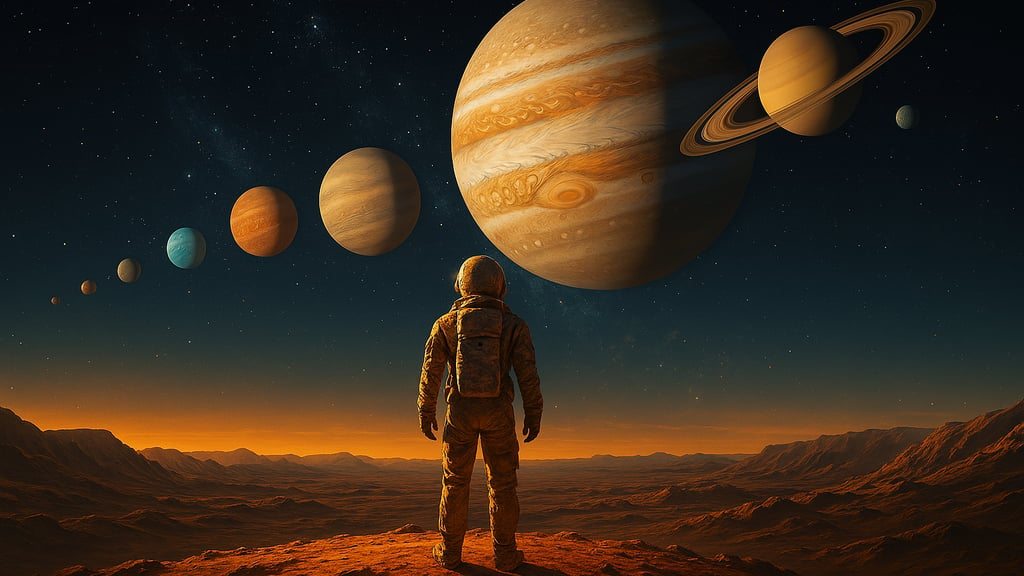How Long Would You Survive on Each Planet?
Explore the fascinating concept of surviving on different planets in our solar system. Learn about the harsh conditions of each planet and how long you could survive without specialized equipment. This article delves into the challenges of living on planets such as Mars, Venus, and Jupiter and discusses the science behind space survival.
SURVIVING ON PLANETSSPACE SURVIVALMARS SURVIVALVENUS SURVIVAL
4/9/20254 min read


Introduction
Exploring space has always been a dream for humans. Wondering how long you could survive on other planets is a common thought. Most planets in our solar system are not friendly to humans. Extreme temperatures, harmful atmospheres, and lack of oxygen make survival hard without advanced tech.
In this article, we'll explore how long you could last on each planet. We'll give you a glimpse into your chances of survival on each one.
1. Mercury: The Fiery or Freezing World
Surface Temperature: 430°C (800°F) during the day; -180°C (-290°F) at night.
Atmosphere: Virtually none; very thin atmosphere that offers no protection.
Survival Time: Less than 1 minute
Mercury is the closest planet to the Sun. Its temperature swings are extreme. Daytime temperatures reach 430°C (800°F), while nights drop to -180°C (-290°F).
The planet has no atmosphere. This means no protection from the Sun's radiation or temperature changes. Without proper gear, survival is impossible.
2. Venus: The Inferno
Surface Temperature: 465°C (870°F)
Atmosphere: Thick atmosphere of carbon dioxide with clouds of sulfuric acid.
Survival Time: A few seconds to a few minutes
Venus is called the "hottest planet". Its surface is around 465°C (870°F), hot enough to melt lead. The atmosphere is mostly carbon dioxide, trapping heat.
The pressure is about 90 times greater than Earth's. It's like being 1,000 meters underwater on Earth. The air is also full of sulfuric acid. If you survived the heat and pressure, the acid would poison you. Venus is a deadly furnace.
3. Earth: Our Lifesustaining Planet
Surface Temperature: Varies from -89°C (-128°F) in Antarctica to 58°C (136°F) in the hottest recorded place (Death Valley).
Atmosphere: Composed of 78% nitrogen, 21% oxygen, and trace amounts of other gases.
Survival Time: Indefinitely (with basic necessities)
Earth is the only planet that supports human life. It has a perfectly balanced atmosphere, plenty of liquid water, and moderate temperatures. With food, water, and shelter, you could live here forever.
But, extreme conditions like Antarctica's cold or Death Valley's heat might shorten your survival time. Yet, Earth is the best planet for life.
4. Mars: The Red Desert
Surface Temperature: -125°C (-195°F) at night; up to 20°C (68°F) during the day at the equator.
Atmosphere: Thin, mostly carbon dioxide with some oxygen.
Survival Time: A few hours to a few days without a spacesuit
Mars, known as the "Red Planet," is a place humans might one day call home. But it's very cold, dropping to -125°C (-195°F) at night. The air is too thin to breathe, with little oxygen.
Without a spacesuit, you'd lose consciousness fast. But with one, you could survive for days. Food and water would be key to staying alive.
Companies like SpaceX are exploring the idea of colonizing Mars.
5. Jupiter: The Gas Giant
Surface Temperature: Around -145°C (-234°F) in the upper atmosphere.
Atmosphere: Mostly hydrogen and helium; also ammonia and methane.
Survival Time: None (Impossible to land)
Jupiter is a gas giant with no solid ground. Its atmosphere is mostly hydrogen and helium. It also has toxic ammonia, methane, and other harmful chemicals.
The upper atmosphere is -145°C (-234°F), freezing in seconds. The pressure and storms, like the Great Red Spot, are too much. Even if you could survive, the radiation from Jupiter's magnetic field would be deadly. Survival on Jupiter is impossible.
6. Saturn: The Ringed Wonder
Surface Temperature: Around -178°C (-288°F).
Atmosphere: Mostly hydrogen and helium, with traces of methane and other gases.
Survival Time: None (Impossible to land)
Like Jupiter, Saturn is a gas giant with no solid surface. It's extremely cold, around -178°C (-288°F). The atmosphere is mostly hydrogen and helium, with some methane and other gases.
If you entered Saturn's atmosphere, you'd face toxic gases and suffocate quickly. Even in the upper atmosphere, the intense pressure and radiation would overwhelm you. Survival on Saturn is impossible.
7. Uranus: The Frozen Giant
Surface Temperature: -224°C (-371°F).
Atmosphere: Hydrogen, helium, and methane.
Survival Time: None (Impossible to land)
Uranus is a ice giant with a mostly hydrogen, helium, and methane atmosphere. Its frigid temperatures of -224°C (-371°F) would freeze anyone instantly. There's no solid surface to stand on, and the extreme cold and high pressures make survival impossible.
Even though Uranus doesn't have violent storms like Jupiter or Saturn, its lack of oxygen, extreme cold, and inhospitable conditions make it unsuitable for life.
8. Neptune: The Distant Cold World
Surface Temperature: -218°C (-360°F).
Atmosphere: Primarily hydrogen, helium, and methane.
Survival Time: None (Impossible to land)
Neptune, the furthest planet from the Sun, is also an ice giant with temperatures that plummet to -218°C (-360°F). Its atmosphere is mostly hydrogen, helium, and methane, with no oxygen or breathable gases. The freezing temperatures, lack of solid surface, and high pressure make survival impossible.
Even the wind speeds on Neptune can reach up to 2,100 kilometers per hour (1,300 mph), adding further danger. Neptune is one of the most hostile environments in our solar system.
Conclusion: Survival in Space? Not for Long
Space is a harsh and unforgiving environment. Most planets in our solar system are completely inhospitable to human life. Mercury and Venus are incredibly hot, while the gas giants like Jupiter, Saturn, Uranus, and Neptune lack solid surfaces and have extreme atmospheric conditions.
Mars, while the most likely candidate for future human exploration, would require advanced technology and life support systems for survival. Earth remains the only planet that provides the right combination of air, temperature, and gravity for human life to thrive.
Until humanity can develop technologies that allow us to live in space or colonize other planets, we remain limited to Earth.

